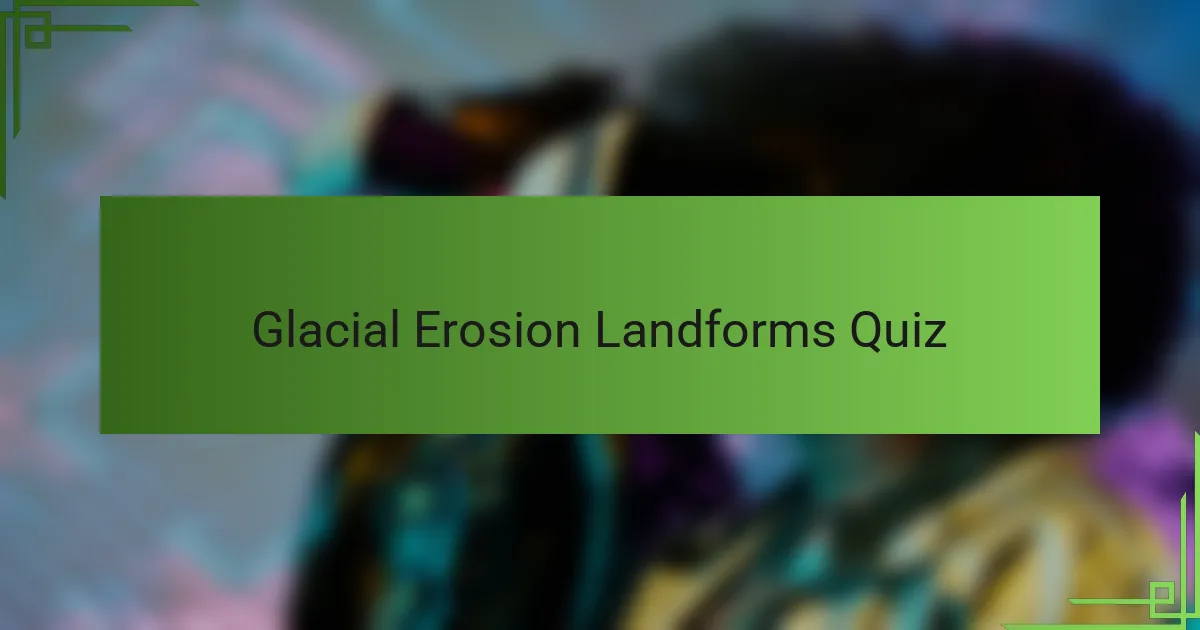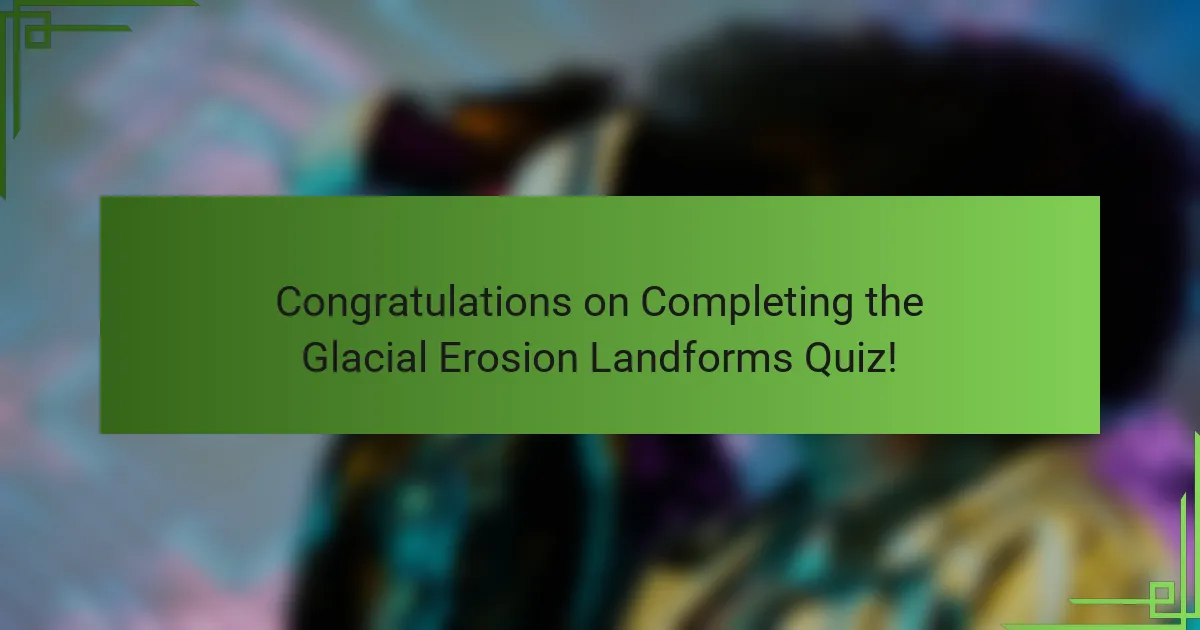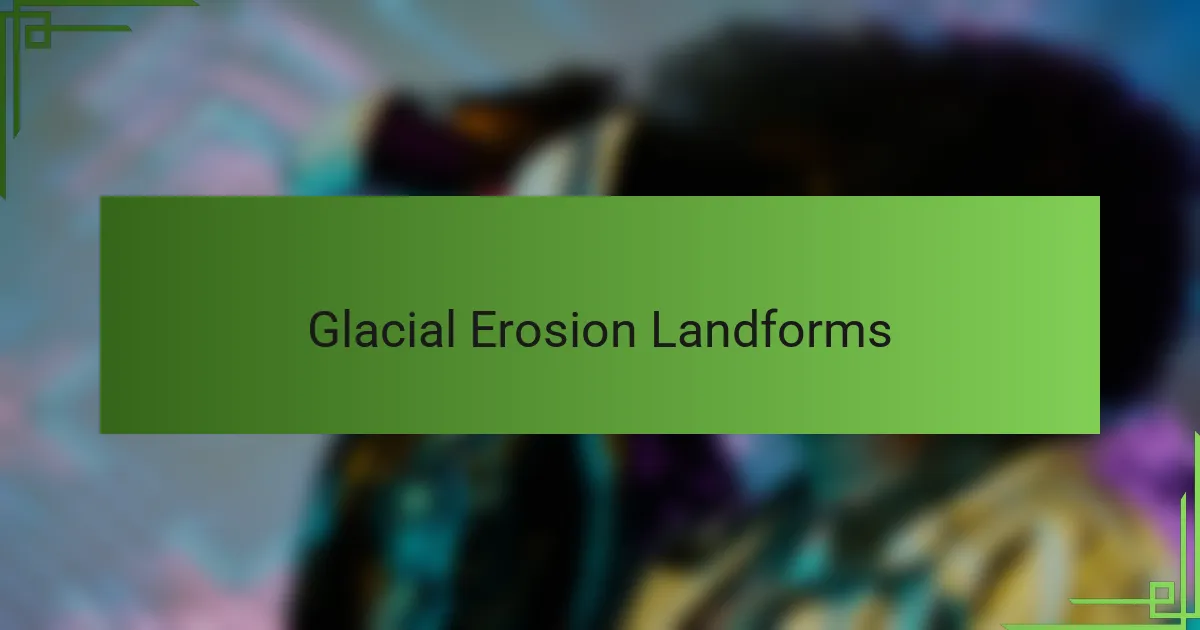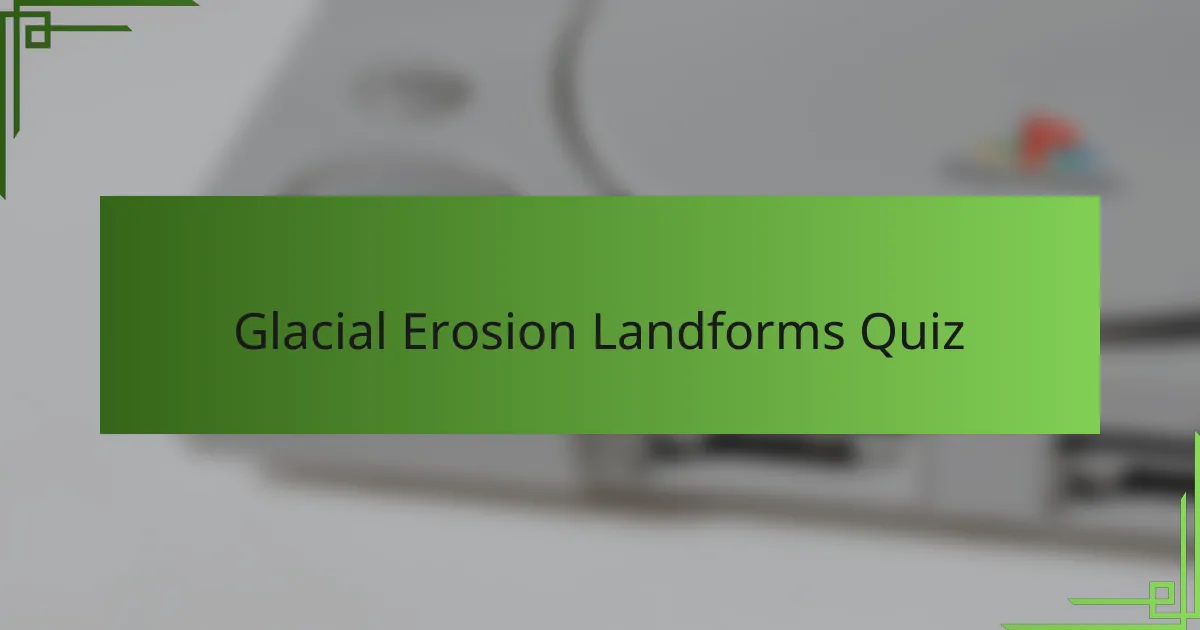
Glacial Erosion Landforms Quiz
1. What is the name of the steep, pyramidal peak formed by glacial erosion on multiple sides of a mountain?
- Horn
- Cirque
- Roche moutonnée
- Arete
2. Which glacial landform is characterized by an elongated, streamlined hill composed of till shaped beneath a moving glacier?
- Drumlin
- Morraine
- Kame
- Esker
3. What term describes the sharp ridge found between two glacial valleys created by erosional activity?
- Arete
- Col
- Drumlin
- Moraine
4. Which type of depression formed by glacial erosion often fills with water to create a tarn?
- Esker
- Cirque
- Kettle
- Drumlin
5. What is the name given to the U-shaped valley carved by the movement of glaciers?
- Hanging valley
- Cirque
- Fjord
- Glacial trough
6. Which glacial feature, typically found at the head of a glacial valley, is a steep-walled hollow formed by frost action and plucking?
- Arete
- Moraine
- Drift
- Cirque
7. What term is used for the smooth, polished rock surface created by abrasion under a glacier?
- Moraine smoothing
- Glacial polish
- Arete polishing
- Striation abrasion
8. Which landform is formed from the accumulation of rock debris at the side of a glacier?
- Kame
- Drumlin
- Moraine
- Esker
9. What is the term for the crescent-shaped gouge carved into bedrock by glacial abrasion?
- Roche moutonnée
- Kame
- Drumlin
- Erratic
10. Which type of valley is characterized by a flat floor and steep walls, resulting from glacial erosion?
- Fjord valley
- Hanging valley
- V-shaped valley
- U-shaped valley
11. What is the name of the large basin-shaped depression formed by the erosive activity of a glacier?
- Arete
- Tarn
- Cirque
- Drumlin
12. Which glacially eroded feature is known as a hollow or small cirque lake?
- Cirque
- Fjord
- Tarn
- Kettle lake
13. What is the term for the sharp, knife-edge ridge between two adjacent glacial valleys?
- Moraine
- Horn
- Arete
- Cirque
14. Which famous mountain landform in the European Alps is an example of a horn formed by glacial erosion?
- The Matterhorn
- Eiger
- Weisshorn
- Mont Blanc
15. What is the name of the depositional feature formed at the terminal edge of a glacier, often confused with erosional landforms?
- Drumlin
- Kame
- Moraine
- Esker

Congratulations on Completing the Glacial Erosion Landforms Quiz!
You’ve just taken an important step in understanding how glaciers shape our planet. This quiz helped highlight key landforms created by glacial erosion, such as cirques, arêtes, and U-shaped valleys. Recognizing these features deepens your appreciation of Earth’s dynamic processes and the powerful role glaciers have played during past ice ages.
By exploring these landforms, you likely gained insights into how ice movement carves and transforms landscapes over time. This knowledge is essential for anyone interested in physical geography, geology, or environmental science. It also offers context for studying climate change and its impact on glacial regions today.
To continue your learning journey, we invite you to check out the next section on this page. There, you’ll find detailed information about glacial erosion landforms that expands on what you have just explored. Dive deeper to enhance your understanding and enjoy discovering more fascinating aspects of geography.

Glacial Erosion Landforms
Introduction to Glacial Erosion Landforms
Glacial erosion landforms are distinctive physical features shaped by the movement and activity of glaciers. These landforms result from processes such as plucking and abrasion, where glaciers erode the bedrock beneath and around them. The landscapes shaped by glacial erosion provide key insights into past and present glaciation, revealing information about Earth’s climatic history and tectonic movements. Examples include U-shaped valleys, cirques, and fjords, which characterize formerly or currently glaciated regions such as the Alps, Himalayas, and the Scandinavian Peninsula.
Formation and Characteristics of U-Shaped Valleys
U-shaped valleys, also known as glacial troughs, form when a glacier moves through a pre-existing V-shaped river valley, widening and deepening it through abrasion and plucking. The resulting valley cross-section is broad and rounded, contrasting sharply with the narrow, angular V-shape carved by rivers. These valleys are prominent in mountain ranges like the Rocky Mountains and the Pyrenees, indicating extensive glacial carving during ice ages. Their presence marks areas of significant glaciation and ongoing glacial influence.
Role of Cirques in Glacial Erosion Landscape
Cirques are amphitheater-shaped depressions found at the heads of glacial valleys formed by ice accumulation, freeze-thaw action, and glacial erosion. These bowl-like hollows typically feature steep back walls and a flat or gently sloping floor, created by glacial plucking and abrasion. Cirques often serve as the birthplace of mountain glaciers, with examples seen in the Jura Mountains and the Scottish Highlands. Their morphology helps geographers identify areas of past glacial activity and reconstruct ice movement patterns.
Characteristics and Significance of Aretes and Pyramidal Peaks
Aretes are sharp, narrow ridges formed between two adjacent glacial valleys or cirques, created by the erosive action of glaciers on both sides. When several cirques erode a mountain from different sides, a pyramidal peak emerges, exemplified by the Matterhorn in the Swiss Alps. These jagged landforms signify intense glacial sculpting and serve as indicators of glacial divide zones. Their distinct shapes influence local ecosystems and geomorphological dynamics.
Formation Processes and Examples of Fjords
Fjords are deep, narrow sea inlets formed by glacial erosion of U-shaped valleys that became inundated by rising sea levels after glacial retreat. Characterized by steep walls and great depths, fjords demonstrate the tremendous erosive power of marine-terminating glaciers. Notable examples include the fjords of Norway, New Zealand’s South Island, and British Columbia. Their unique formation links glacial geology with coastal geography, highlighting interactions between glaciers and ocean processes.
What are Glacial Erosion Landforms?
Glacial erosion landforms are physical features shaped by the movement of glaciers removing, transporting, and reshaping rock material. Examples include U-shaped valleys, cirques, arêtes, and fjords, all formed due to glacial abrasion and plucking processes. These landforms are present where glaciers have existed historically, such as the Alps, the Rockies, and Scandinavia, proving their origins are directly linked to glacial activity.
How do glaciers create U-shaped valleys?
Glaciers create U-shaped valleys by moving downhill, eroding the valley floor and walls through processes called abrasion and plucking. Unlike rivers that carve V-shaped valleys, glaciers scour the landscape more broadly and deeply, resulting in a characteristic U-shaped cross-section. This transformation from V-shaped to U-shaped valleys is evident in glaciated regions like the Yosemite Valley in the United States.
Where are major examples of cirques formed by glacial erosion found?
Major examples of cirques, which are bowl-shaped depressions formed by glacial erosion, are found extensively in the European Alps, the Scottish Highlands, and the Southern Alps of New Zealand. These areas exhibit classic cirques due to historical glaciation, supported by geological surveys identifying their characteristic amphitheater-like shape carved into mountain sides.
When did most of the prominent glacial erosion landforms develop?
Most prominent glacial erosion landforms developed during the Quaternary period, especially in the last Ice Age, approximately 2.6 million to 11,700 years ago. This period saw vast ice sheets covering large parts of North America, Europe, and Asia, as confirmed by sediment analysis and radiocarbon dating techniques that date glacial deposits and identify erosional features formed in this timeframe.
Who studies glacial erosion landforms in geography?
Physical geographers and geomorphologists primarily study glacial erosion landforms to understand earth surface processes and landscape evolution. They use field measurements, remote sensing, and GIS technology to analyze features shaped by glaciers. Institutions like the Geological Society of America and universities with geography departments conduct extensive research in this field.
